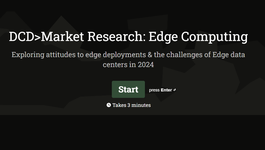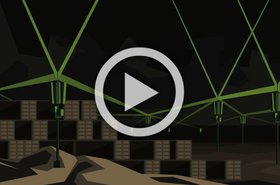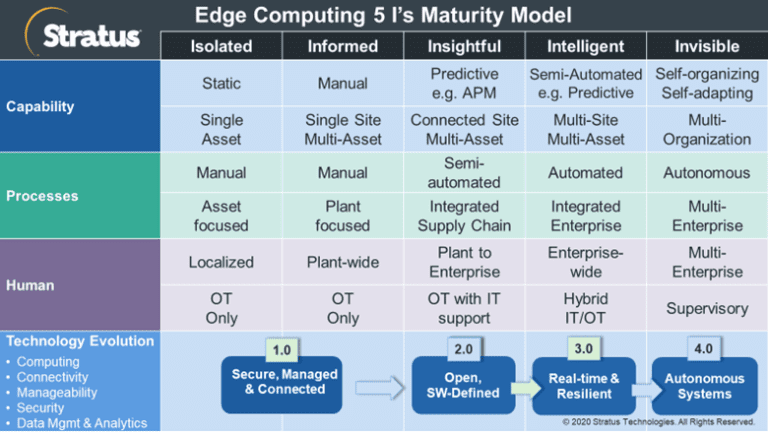As industrial companies embark on their digital transformation journeys, they will undoubtedly find a need for edge computing technology. As they do, it’s helpful to keep in mind the end goal: achieving complete convergence of information technology (IT), operational technology (OT), and autonomous edge computing in the age of Industry 4.0.
Autonomous edge computing is akin to autonomous vehicles: it’s when IT and OT are fully converged, enabling self-managing, self-healing, and self-organized systems. As an industry, we are years away from this level of achievement, but it’s the direction the industry is and should be striving for.
At Stratus Technologies, where I serve as Chief Technology Officer, we developed an edge computing maturity model that captures the “5 I’s” of edge transformation: Isolated, Informed, Insightful, Intelligent, and Invisible. The chart below describes each stage of the maturity model. As edge capabilities become more modernized, companies digitally transform towards “Invisible.”
Edge 1.0 and 2.0
Along with the 5 I’s Maturity Model, we also talk about the advancement and adoption of technology related to edge computing. Today, most organizations are at the Edge 1.0 stage, where fundamental capabilities are needed for successful business operations. The final stage, Edge 4.0, however, is where true autonomy is prevalent.
Edge 1.0 is all about how you secure, manage, and connect machines and devices to enable a digital edge — all fundamental capabilities for any business to successfully operate in a digital world. This is the predominant stage where most companies are operating in their digital transformation journey.
The next stage, 2.0, sees the adoption of open, software-defined technologies at the edge. Software-defined technology is where various functions are abstracted from underlying computer hardware, enabling them to be performed in software. It is the same concept behind server virtualization, which has been with us for many years now. More recently, it’s been applied to areas including computing, storage, networking, and security.
Software-defined networking (SDN), for example, enables companies to more easily manage their networks because they can make changes to attributes including routing tables, configurations, and policies from a centralized control platform, rather than having to make changes to individual switches.
Similarly, software-defined technology enables the delivery of cloud-based security services, obviating the need for companies to own and operate their own firewalls, intrusion detection/prevention systems, and the like.
Edge 3.0 and 4.0
At the 3.0 stage, things really start to get interesting. This is where we see true IT/OT convergence taking place with resiliency and real-time capabilities.
Today, we have numerous pockets of industrial environments that IT doesn’t touch.
A factory, for example, will have control systems for machinery that ensure deterministic behavior and safety. These control systems are born out of the operational technology world, not from the information technology industry.
That is starting to change, as we see technologies used in data centers migrate to the industrial edge. By around 2025, I expect we’ll see concepts like virtualization applied to industrial environments, delivering real-time, machine-level capabilities in areas such as safety, control systems, and other traditional operational functions. Industrial environments will take advantage of cloud and enterprise data center capabilities such as resilience and fault-tolerance, which have long been features of the IT world. In effect, it’s converging the physical industrial world to an open, software-defined model, as has been the trend in the IT world for years.
Achieving 3.0 capabilities is an essential transition to reaching Edge 4.0, where IT and OT infrastructure and operations are converged with artificial intelligence (AI). This is the state at which we see a self-managed, self-healing and autonomous industrial environment. When a machine starts developing a problem, AI systems diagnose it and issue a fix — no humans required.
It will be another 10 years or so before we see this vision take hold, but the digital transformation journey at the edge has already started. Be mindful that there’s no leapfrogging from, say, Edge 1.0 to 3.0. You have to build in capabilities that define each stage before you can reach the next. But the end result will be transformational, bringing modernization, flexibility, efficiency, and resiliency to the industrial world.
More from Schneider Electric (Life Is On)
-

-

Sponsored Assessing sustainability
-



